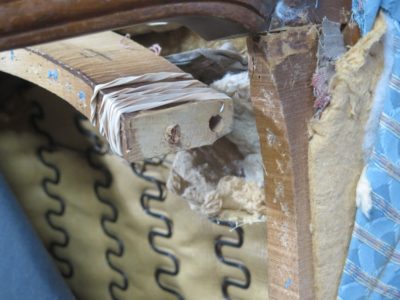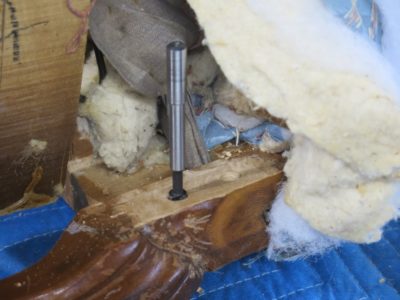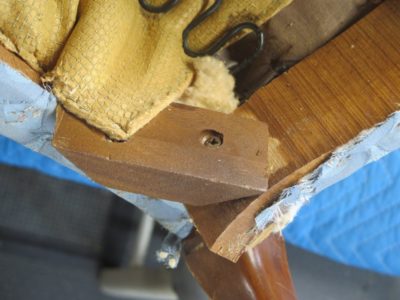D’s Broken Chair – Part II

The work of repairing D’s broken chair leg had the additional challenge of intact upholstery in place, and I had no desire nor skill to peel it all back to do the work. This is not the first time I have had a similar challenge of making a fundamental structural repair to a piece of seating furniture without the luxury of really intruding into the fabric of the object One notable example of this problem was a c.1800 painted shield-back chair with a very old hand woven cane seat and a snapped side rail. The client insisted that the repair leave both the painted surface and the hand-woven cane intact, yet restored so solidly that the chair could be used on a daily basis.


In the case of D’s chair I had to peel back the dust panel and just enough of the upholstery so that I could get access to the damaged area. That consisted of a blowed-up-real-good corner joint with snapped off dowels, blown out seat rail end, and everything under stress from both the upholstery itself and the underlying springs which were still affixed to the frame.

The front rail had been pretty busted up and the dowels damaged and even broken off. I made the first repair by reassembling the broken seat rail, using PVA and rubber bands as the clamping mechanism.

I gently drilled out the center of the broken dowel after first cutting it smooth with the joint face. After removing most of the mass with the smaller drill I cleaved off the remaining dowel mass with a small carving gouge until I got everything removed that I could do safely. Using the proper sized drill bit I “re-drilled” the dowel hole by hand. That made the reassembly pretty straightforward.


I also had to remove the corner brace completely, as it had broken loose and was not properly aligned even when the chair was new. After cleaning the gluing surfaces and placing it properly, once reglued and screwed it was mighty strong.


Reassembling the complete structure of the corner took a whole lot of clamps just to get things aligned, remember that the springs were still holding the deck together and exerted a lot of force making the configuration an issue. I carefully placed the upholstery back where it belonged, doing my best to overcome the puckering induced by the original structural damaged puling the fabric out of place.

It sat under a furniture pad until the D’s husband came to pick it up, and then it was on to the next project.



Join the Conversation!